#gnathostomulida
Text
Phylum Round 1
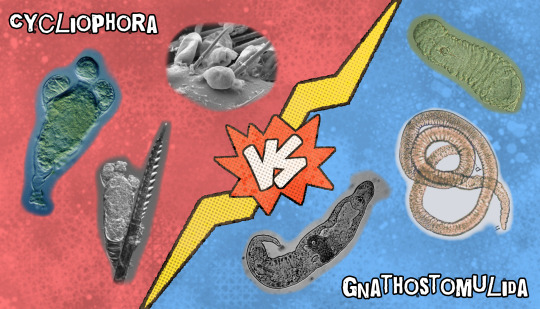
Cycliophora: An incredibly specialized phylum, the Cycliophorans consist of a single genus. These animals live exclusively on the mouthparts of lobsters. Yes, all Cycliophorans. This is considered a commensal relationship, as the lobster is not harmed by the Cycliophorans' presence. This phylum has an interesting reproductive strategy involving cloned dwarf versions of the male, embryos that drain all nutrients from the mother, and larvae that must be strong swimmers to hopefully re-colonize the host lobster's new exoskeleton whenever it molts.
Gnathostomulida: Jaw Worms. All animals in this phylum are "meiofauna", meaning they live in the spaces between grains of sediment on the seafloor. They are covered in hair-like cilia, which aids in navigating their micro-environment. As the name implies, they have a strong set of jaws, often with tiny teeth for grinding food. They are hermaphroditic, and strangely, each "lays" a single egg that breaks through the parent's body wall and adheres to a nearby grain of sand. Thankfully, the parent is able to quickly heal from this wound. These animals are important for maintaining chemical cycles between the sediment and water above, and they are a rich food source for higher organisms in the bottom-dwelling food chain. They are also very sensitive to pollution, making them important "bio-indicators".
#micro royale#not tagging this as para/sites because the cycliophorans aren't doing anything bad they're just hanging out#cycliophora#gnathostomulida#animal bracket#tumblr bracket#bracket tournament#poll bracket#phylum round 1#phylum
56 notes
·
View notes
Text
Phylum #20: Gnathostomulida, the jaw worms!
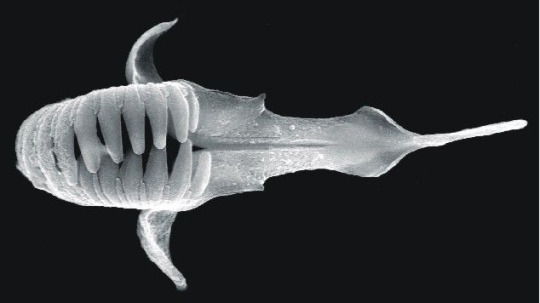
Truly, all four gnathiferan phyla deserve the name of "jaw worms". They're worms (which as far as bilaterians go is pretty much a "default" category), and they have jaws. But the minute gnathostomulids are, in a way, the simplest, most archetypal "worms with jaws".
At most a millimeter long, adapted to live in shallow marine sediments, jaw worms are a typical component of the meiofauna. Which means, no need for futilities like a respiratory or circulatory system - cellular diffusion is more than enough! Even the digestive tract has been simplified, with no anus to be found.
With half of their body dedicated to sex organs, their reproduction strategy has to be peculiar. Fertilize each other (they're hermaphrodites!), produce an egg, and rupture the body wall to let it out. And patch the resulting wound as if it was nothing. Yes, they're that badass.
What about their fearsome jaws? Well, they'd much smaller than you'd imagine. In fact, their snout covered in whiskers-like cilia is much more visible. These are their only sense organs, with which they find prey before scooping them up with their basal plate and catching them with the other two jaws!
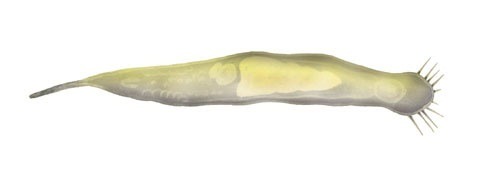
76 notes
·
View notes
Text
WAR AND HATE ON PLANET EARTH
WELCOME TO THE PHYLUM PHIGHT
A BRACKET WHERE THE 37 KNOWN PHYLA OF ANIMALS (extant and otherwise) WILL BATTLE TO THE DEATH. ONLY ONE MAY BE CROWNED CHAMPION-- AND ASCEND TO THE STATUS OF KINGDOM (i have this power)
WHO WILL IT BE? THE CHORDATES, CONTAINING EVERY KNOWN VERTEBRATE INCLUDING YOU AND ME? I FEEL LIKE THAT'S A BIAS. MAYBE THE HUMBLE TARDIGRADES, THE INTERNET'S FAVOURITE EXTREMOPHILES? OR WILL IT BE THE PENIS WORMS? I FEEL LIKE IT'S GONNA BE THE PENIS WORMS.
TOURNAMENT STRUCTURE:

ok ditching allcaps now <3
round 0
preliminary face-off between the odd phellas. lasting one (1) week to give bitches time to mobilise
protoarticulata VS rhombozoa
2. phoronida VS vetulicolia
3. petalonamae VS xenacoelomorpha
4. porifera VS rotifera
5. platyhelminthes VS saccorhytida
round 1
all round 1 poll-batches will last one (1) day because dear god there are so many of them. there will however be a cooldown of like, a couple days or something between batches because i am but one man
batch 1 - BATCH TO THE DEATH
6. priapulida VS winner of 1
7. annelida VS chaetognatha
8. trilobozoa VS micrognathozoa
9. bryozoa VS lorcifera
batch 2 - THE BATCHENING
10. tardigrada VS winner of 2
11. brachiopoda VS gastrotricha
12. mollusca VS winner of 3
13. nematomorpha VS gnathostomulida

batch 3 - BATCHETFIELD HIGH
14. chordata VS winner of 4
15. archaecyatha VS cycliophora
16. nematoda VS nemertea
17. ctenophora VS kinohyncha
batch 4 - I HAVE RUN OUT OF BATCH PUNS
18. arthropoda VS winner of 5
19. agmata VS entoprocta
20. cnidaria VS onychophora
21. echinodermata VS hemichordata
round three wait and see!!!
this bracket doesn't require nominations, as the candidates are already set out all nicey for us by Science. how cool of them. Now we make them beat each other senseless for our sick amusement :)
HOWEVER please send asks, suggest representative species or images to make sure we see them at their best, send propaganda/fun facts youd like the filthy electorate to know before they condemn your fav to the deepest most basal pits of taxonomic superhell. lets all get to know the Beasts together. Before we make them fight to the death.
-mod riz (he/him)

ROUND 0 START: APRIL 10TH
#phylum phight#phylum-phight-tourney#tumblr tournament#taxonomy#tumblr polls#tournament#poll tournament#animal tournament#biology#cnidaria#bryozoa#chordata#arthropod#echinoderm#molluscs
32 notes
·
View notes
Text
Okay, have some fun facts about all of the small (under 1,000 known species) animal phyla that I found diving through Wikipedia.
Brachiopoda: Used to fill the position that bivalves fill now, which technically makes bivalves Brachiopoda 2.0.
Chaetognatha: Some species have an “oil vacuole” organ that might help them maintain buoyancy (basically a swim bladder). Also, some of them produce tetrodotoxin. Also also, some of them are bioluminescent.
Ctenophora: Double anuses (only recently discovered). Also, they used to have skeletons.
Cycliophora: Weirdly complex reproductive cycle involving two modes and three sexes (female / male / sexless). Would make an interesting basis for a fictional species… if you can even understand what’s going on.
Dicyemida: Alternation of generations, apparently.
Entoprocta: Organs can do a complete 180° flip in position during metamorphosis.
Gastrotricha: Live for only a few days, and their bodies are “filled with poorly differentiated connective tissue”.
Gnathostomulida: Instead of laying eggs like reasonable animals, they have their eggs straight-up BURST OUT OF THE PARENT’S BODY. (They’re fine, though.) Also, they have no (permanent?) anus.
Hemichordata: Can have a hundred pairs of gill slits.
Kinorhyncha: Retractable head.
Loricifera: Some species can survive without oxygen. Whether or not they even have mitochondria is up for debate.
Micrognathozoa: Fifteen-part jaws… on an animal that’s only 100 micrometers long. They certainly live up to their name.
Nematomorpha: Because they can influence their hosts to enter water, they help feed certain types of fish.
Onychophora: Unexpectedly complex social structure. Also, they are matriarchal (girlboss).
Phoronida: “The blood of Phoronis architecta carries as much oxygen per cm3 as that of most vertebrates; the blood’s volume in cm3 per gm of body weight is twice that of a human.”
Placozoa: Have several different types of sodium channels for some reason.
Priapulida: Very dense populations despite the small number of species.
Xenacoelomorpha: One species is photosynthetic because of symbiotic algae (also, two of the common names for that species are “mint-sauce worm” and “shilly-shally worm”).
10 notes
·
View notes
Photo
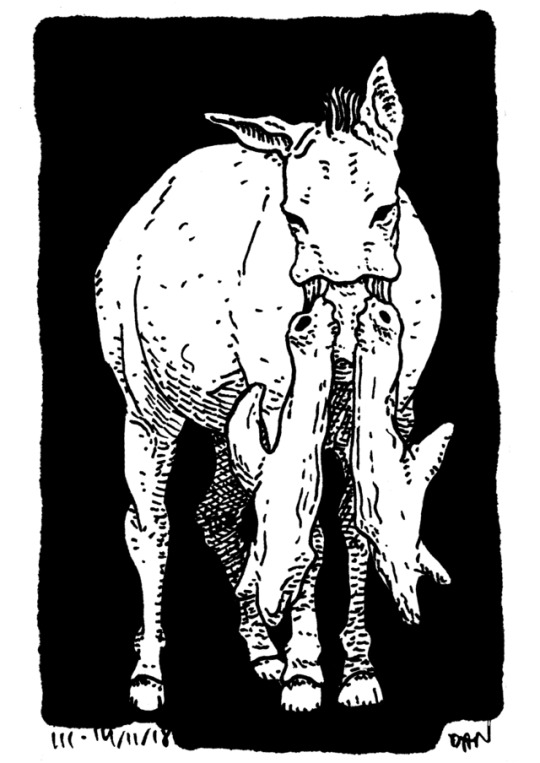
#phyla challenge#dimetrodone#day 11 : Gnathostomulida#Haplognathia#donkey#snap snap snap#the Unknown#chimera#111#octem 14#terra 1
25 notes
·
View notes
Text
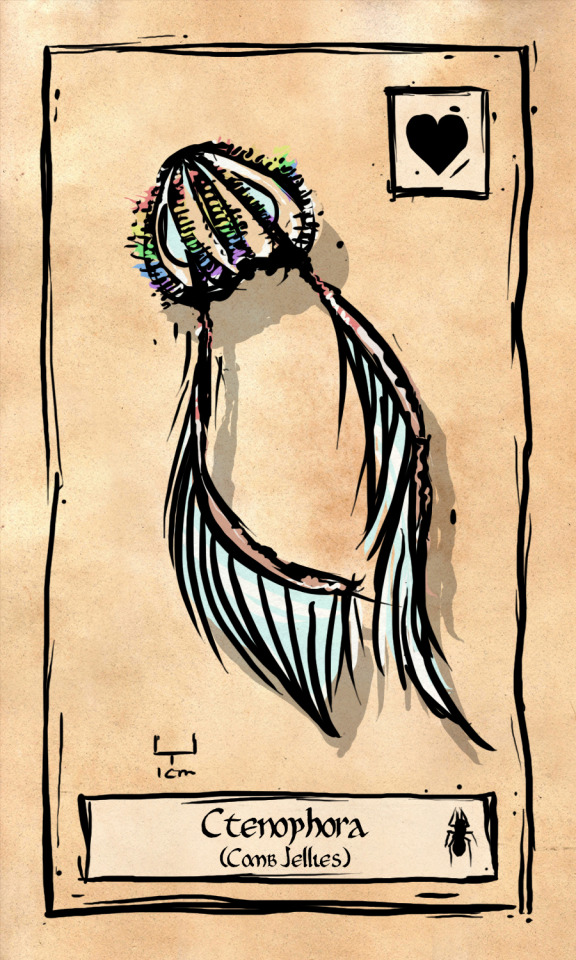



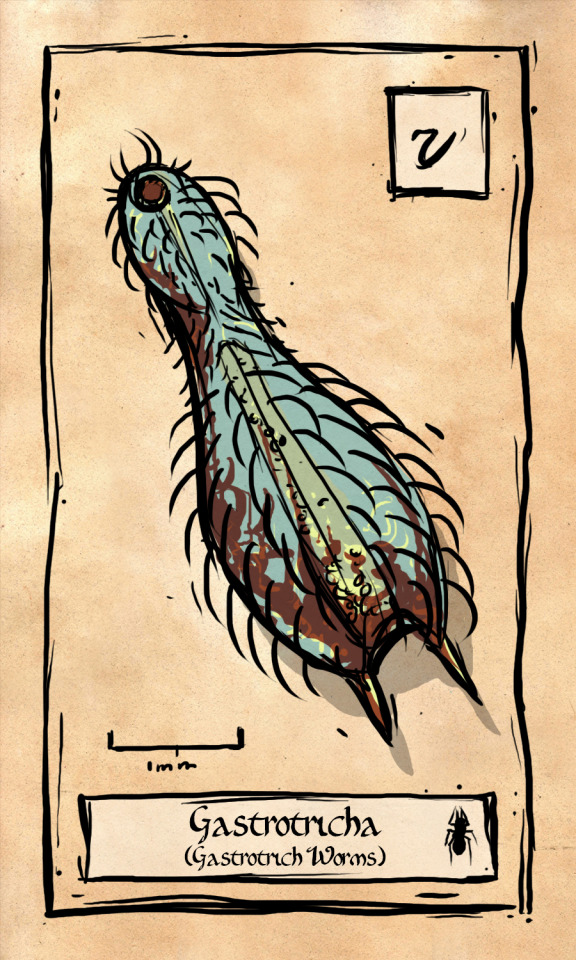
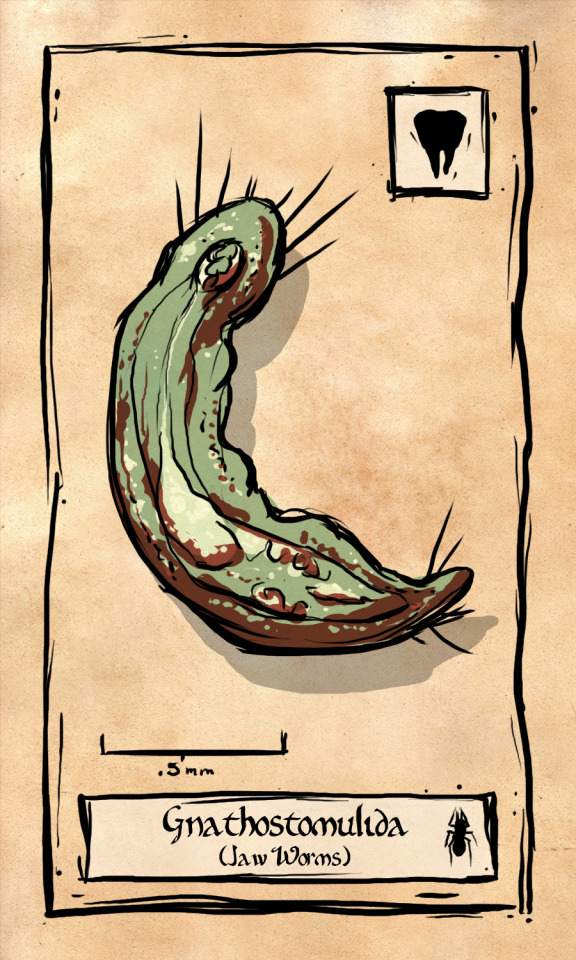


Card descriptions under cut:
Ctenophora – The Comb Jelly card represents glamour, elegance, and allure. Beauty may be found past or present in events, no matter how strange or confusing they may be. Look to find the wonder of that which has or will happen, especially finding love for an aesthetic that may be unfamiliar or confusing. Despite their alien form, the elegantly undulating 'combs' of these animals shimmer with a rainbow of iridescence as they move through the water.
Cycliophora – The Symbion card represents a unique situation, opportunity, or event. This may be something to be grasped at or avoided based on the surrounding cards. If considered in a past sense it could be a particularly difficult adversity overcome, or a singular opportunity taken in hand. If looking toward the future this may foresee some very different event in the subject's life about to take place, something they have not yet dealt with before. These highly specific animals exist only on the whiskers of a few species of lobsters, living out their lives neither helping or harming their hosts. Their unique place in the tree of life gives them a highly specialized lifestyle, and make them stand out among more diverse phyla.
Echinodermata – The Urchin card represents symmetry. Look for balanced aspects of events past and future. If something seems amiss in a reading, or looking forward or back, look to find its paired meaning �� something which exists in harmony with or in opposition to what you find, depending on where the hole may lie. This may be a call to action or simply an act of introspection. While not everything will have a pair, knowing it's vacancy may assist in finding meaning or understanding. With their radial symmetry, this phyla is possessed of body plans which extensively feature symmetry in all aspects.
Entoprocta – The Goblet worm's distinct phylogeny gives it an overt meaning, symbolizing a cup. A cup, or vessel holds and contains. It can be filled or poured over. This can represent a bountiful thing or perhaps something that is too much. A cup can be empty, drained, and this can be represented as well. The subject of the reading will determine what meaning can be best understood, but look for fullness or emptiness and a willingness to contain what will be offered in the future. Entoprocta overall bear a superficial resemblance to a cup or goblet, sharing many similarities with other aquatic colonial animals composed of zooids.
Gastrotricha – The Gastrotric worm card represents quickness. Move with haste toward both goals and obstacles. Think quickly and move with speed. Lingering on decisions and options and wondering over various outcomes overburdens the point, simply live and keep living. On a whole, the members of this phyla have very short lives, generally a few days to a couple weeks, and must therefore live quickly. They are complex, but small, and must keep going with haste in order to live their lives thoroughly and efficiently.
Gnathostomulida – The Jaw Worm card represents teeth. Arm yourself tooth and nail, bare your fangs, and bite. Gnathostomulids are small, substrate dwelling worms, many of which survive in extremely anerobic environments. Their most notable feature is their pointy teeth and strong jaws.
Hemichordata – The Acorn Worm card represents the rather nebulous idea of 'almost'. In life, no matter how hard one tries, or sometimes simply by chance there will be 'almost' moments. Times when things almost came together, almost worked, almost won. While it is easy to feel these times a disappointment, it is important to remember the strength of almost as well – almost hit, almost out, almost missed. Consider where there has been an almost, and look to accept the outcomes it may have presented. Hemichordata are a phylum of worm-like animals who are the closest related extant phyla to chordates (along with echinoderms), possessing a stomochord – a hollow tube which serves to communicate with the oral cavity. Despite the rough physiological resemblance, it is not entirely akin to a notochord, and not necessarily evolutionarily related.
Kinorhyncha – The Mud Dragon card finds its meaning in its namesake's lifestyle, obscured within the mud, much is unknown about this phyla. A reading including this card may mean that its own meaning could be obscured, something may be unclear or difficult to find either in life or in the layout of the cards. It may be prudent to deeply consider each card and its meaning within a reading, rather than to look for quick and easy connections. Small invertebrates, this cosmopolitan species is found in most marine sediment around the world, and yet their classification remains elusive.
20 notes
·
View notes
Text
dimetrodone 30 day phylum art challenge: day 11 Gnathostomulida

Ugghhh another basic worm.. they’re close to rotifer
6 notes
·
View notes
Text
Official Phylum Bracket!
Below is the official matchup list for the Phylum rounds!
There are 33 phyla in the Showdown lineup, so after the polls close on Round 1, the winner of Xenacoelomorpha vs. Hemichordata will go up against Micrognathozoa in Round 1.5 before we move on.

How this bracket was created:
After assembling the list of phyla, I ranked them based on my best guess of how they would perform in the polls. I then split the list into the Top 16 and the Bottom 16 (minus Micrognathozoa), and created a bracket for each half using this site. I split up the list because it felt unfair not to give the less charismatic phyla at least a chance to compete! I've been affectionately calling the Bottom 16 matchups the "Micro-Royale" :) From there, I created a new bracket, alternating matchups between the Top 16 and Bottom 16.
Since Tumblr is probably going to crunch the image quality, the bracket matchups are listed in text format below the Keep Reading.
Round 1:
Round 2:
Arthropoda vs. Brachiopoda
Priapulida vs. Placozoa
Platyhelminthes vs. Onychophora
Loricifera vs. Gastrotricha
Annelida vs. Nematoda
Cycliophora vs. Gnathostomulida
Phoronida vs. Cnidaria
Dicyemida vs. Chaetognatha
Mollusca vs. Bryozoa
Nematomorpha vs. Orthonectida
Nemertea vs. Ctenophora
Acanthocephala vs. Tardigrada
Echinodermata vs. Porifera
Rotifera vs. Kinorhyncha
Entoprocta vs. Chordata
Xenacoelomorpha vs. Hemichordata
>> (Micrognathozoa will challenge the winner of this matchup)
Arthropoda vs. Placozoa
Onychophora vs. Loricifera
Annelida vs. Cycliophora
Cnidaria vs. Chaetognatha
Mollusca vs. Nematomorpha
Ctenophora vs. Tardigrada
Echinodermata vs. Rotifera
Chordata vs. Micrognathozoa
Round 3:
Arthropoda vs. Onychophora
Annelida vs. Cnidaria
Mollusca vs. Ctenophora
Echinodermata vs. Chordata
98 notes
·
View notes
Text
Introducing Life, One Phylum at a Time
Welcome to Forms and Phyla! Each day, a short presentation of one of the animal kingdom's 32 described phyla, highlighting its diversity and uniqueness!
Watch the tree of life - and the blog's profile picture - light up before your eyes, as a new facet of animal diversity is revealed each time!
Click here for the latest post (Gastrotricha, the hairybellies), or see below for the list of posts!
Ctenophora
Porifera
Placozoa
Cnidaria
Xenacoelomorpha
Echinodermata
Hemichordata
Chordata
Loricifera
Kinorhyncha
Priapulida
Nematoda
Nematomorpha
Tardigrada
Arthropoda
Onychophora
Chaetognatha
Rotifera
Micrognathozoa
Gnathostomulida
Mollusca
Entoprocta
Gastrotricha
104 notes
·
View notes
Text
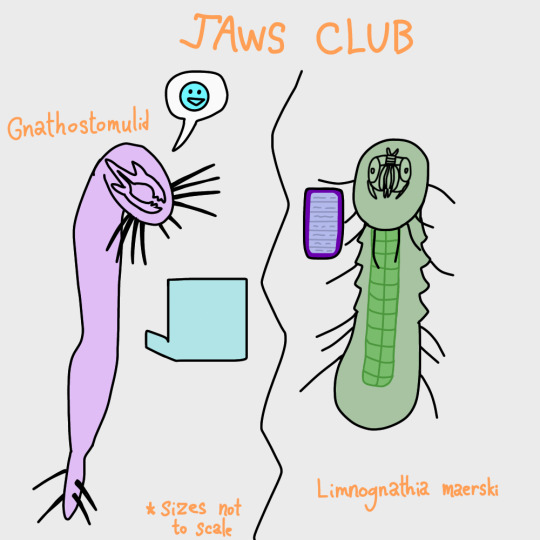
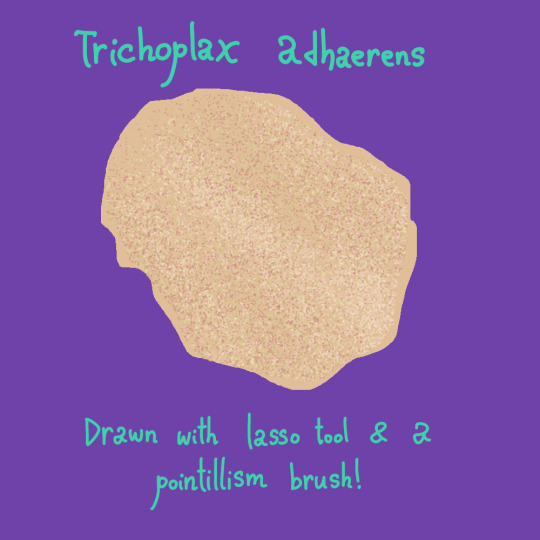


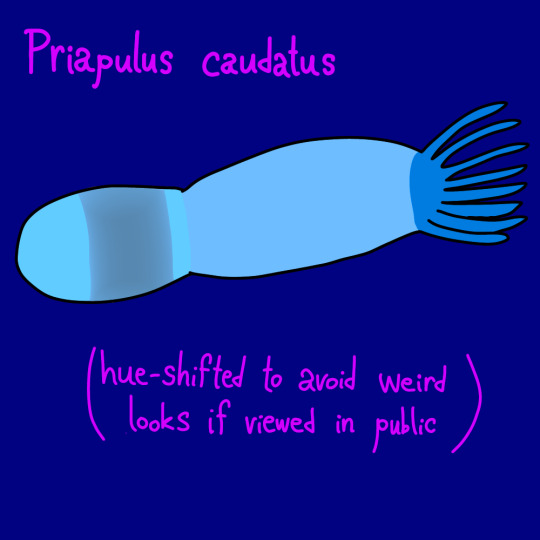
I finished the “Phyla Under 1,000 Species” series I started back in May for InverteFest!
Featuring: Gnathostomulida, Micrognathozoa, Placozoa, Dicyemida / Rhombozoa, Xenacoelomorpha, and Priapulida.
#original art#biology art#while drawing this I realized that micrognathozoan jaws look like an insect head#like a dragonfly or something
2 notes
·
View notes
Note
is Gnathostomulida next? it sure seems like it is with it being the only gnathiferan group that hasn’t been covered
Yes, they're coming today! I'm arranging the posts as a flattened phylogenetic tree, so related clades always end close to each other! Although for the next ones, lophotrochozoan phylogeny is still pretty much in flux so I'll see which ordering I go for (probably Marlétaz et al. 2019)
1 note
·
View note